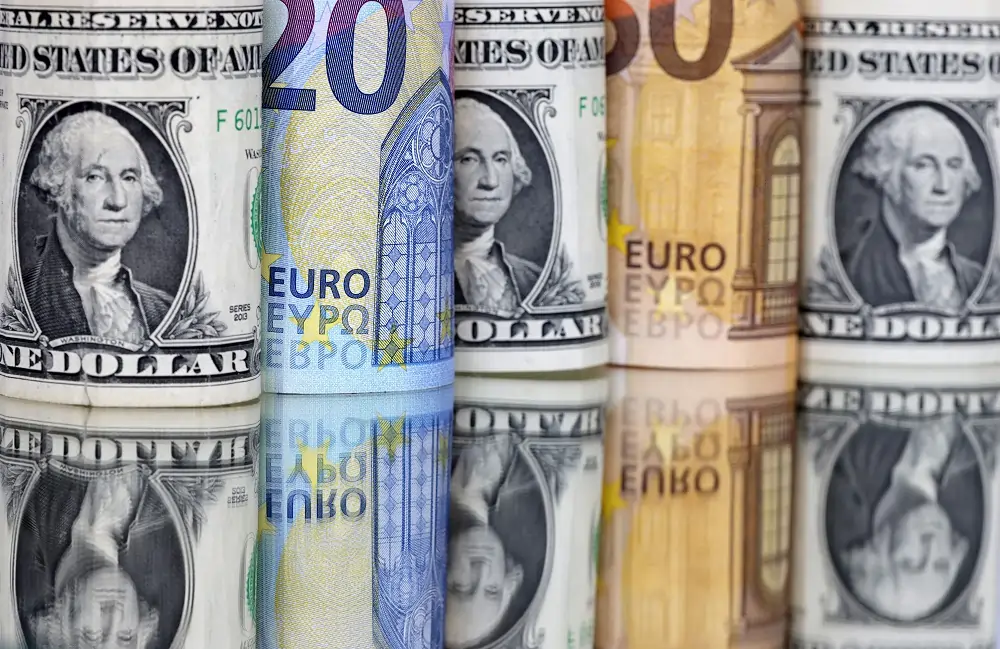
By Herbert Lash and Joice Alves
NEW YORK/LONDON (Reuters) – The dollar slid further on Wednesday as it consolidates a bounce in recent days from surprisingly strong U.S. economic data and pushback from Federal Reserve officials on market expectations of imminent interest rate cuts.
The dollar eased from a nearly three-month high against the euro on Tuesday even as market bets on a rate cut by the Fed in March rebounded. Treasury yields, often a factor in the dollar’s strength when they draw foreign investment, also were lower.
“The dollar’s rally is a bit overcooked, sort of in line with how I’m viewing U.S. yields,” said Brad Bechtel, global head of FX at Jefferies in New York.
“We’ve gone pretty far, pretty fast and we’re kind of bouncing up against some resistance levels.”
The dollar was down 0.14% to $1.0769 per euro, after retreating 0.1% on Tuesday, when it had earlier touched its strongest level since Nov. 14 at $1.0722.
The dollar index, a measure of the U.S. currency against six major peers, including the euro, slipped 0.08% to 104.06, following a 0.29% slide a day earlier. It had reached its highest since Nov. 14 at 104.60 on Monday.
“It’s really data that’s going to drive the next move. In the meantime, we’ll probably consolidate a little bit, pull back a little bit in the dollar, maybe rally a little bit in the euro and sterling,” Bechtel said.
Analysts pointed to technical factors for the dollar’s pullback, following a two-day rally of as much as 1.4% against the euro after unexpectedly strong U.S. jobs data, as well as more hawkish rhetoric from Federal Reserve Chair Jerome Powell, pummeled bets for a rate cut as soon as March.
U.S. Treasury yields gained some respite on Wednesday after falling from this week’s highs on solid demand at a sale of new three-year notes, removing some support for the dollar.
“Despite the ruling out of March rate cut hopes, the market is still showing some reluctance to go all in on the long U.S. dollar trade given the high conviction around rate cuts later in the year,” said Jane Foley, head of FX strategy at Rabobank.
Traders are currently pricing in a 23.5% chance of a rate cut in March, up from 14.5% on Monday, the CME Group’s FedWatch Tool shows. At the start of the year bets saw a 68.1% chance.
A sharper than expected fall in industrial production in the euro zone’s largest economy had no impact on the euro as “Germany’s industrial malaise is now a well-known story”, said Chris Turner, global head of Markets at ING.
The dollar edged 0.04% higher against the yen to 147.99, after sliding 0.49% on Tuesday. The currency pair tends to be extremely sensitive to moves in Treasury yields.
“Financial markets are in the process of recalibrating their expectations for Federal Reserve policy,” said James Kniveton, senior corporate forex dealer at Convera.
“If positive economic data, particularly on inflation, persists in the U.S., the tide could turn towards earlier rate cuts, potentially weakening the greenback further.”
Sterling rose 0.29% against the dollar to $1.2633 after higher house prices in Britain supported bets that the Bank of England (BoE) was not likely to cut interest rates any time soon.
(Reporting by Herbert Lash, additional reporting by Joice Alves in London and Kevin Buckland in Tokyo; Editing by Mark Potter, Emelia Sithole-Matarise and Deepa Babington)


